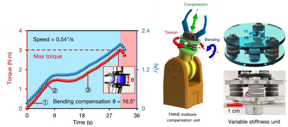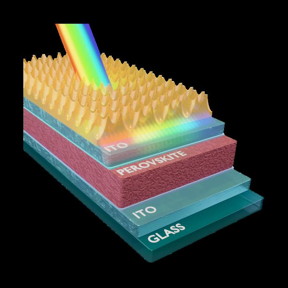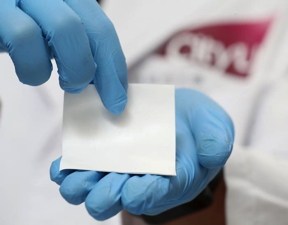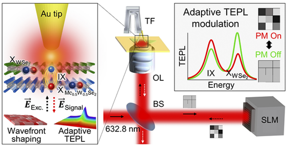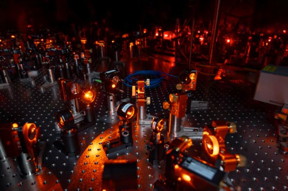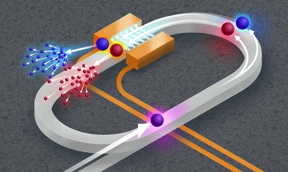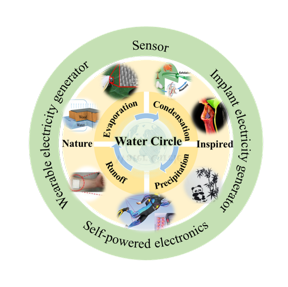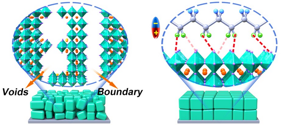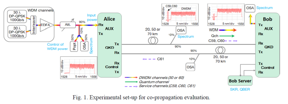Home > Press > New catalyst could dramatically cut methane pollution from millions of engines: Researchers demonstrate a way to remove the potent greenhouse gas from the exhaust of engines that burn natural gas.
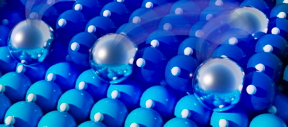 |
| Today’s catalysts for removing unburnt methane from natural gas engine exhaust are either inefficient at low, start-up temperatures or break down at higher operating temperatures. A new single-atom catalyst developed by SLAC National Accelerator Laboratory and Washington State University solves both these problems and removes 90% of the methane. This illustration depicts individual palladium atoms (white) removing methane (white bubbles) at the surface of the catalyst. CREDIT Cortland Johnson/Pacific Northwest National Laboratory |
Abstract:
Individual palladium atoms attached to the surface of a catalyst can remove 90% of unburned methane from natural-gas engine exhaust at low temperatures, scientists reported today in the journal Nature Catalysis.
New catalyst could dramatically cut methane pollution from millions of engines: Researchers demonstrate a way to remove the potent greenhouse gas from the exhaust of engines that burn natural gas.
Menlo Park, CA | Posted on July 21st, 2023
While more research needs to be done, they said, the advance in single atom catalysis has the potential to lower exhaust emissions of methane, one of the worst greenhouse gases, which traps heat at about 25 times the rate of carbon dioxide.
Researchers from the Department of Energy’s SLAC National Accelerator Laboratory and Washington State University showed that the catalyst removed methane from engine exhaust at both the lower temperatures where engines start up and the higher temperatures where they operate most efficiently, but where catalysts often break down.
“It’s almost a self-modulating process which miraculously overcomes the challenges that people have been fighting – low temperature inactivity and high temperature instability,” said Yong Wang, Regents Professor in WSU’s Gene and Linda Voiland School of Chemical Engineering and Bioengineering and one of four lead authors on the paper.
A growing source of methane pollution
Engines that run on natural gas power 30 million to 40 million vehicles worldwide and are popular in Europe and Asia. The natural gas industry also uses them to run compressors that pump gas to people’s homes. They are generally considered cleaner than gasoline or diesel engines, creating less carbon and particulate pollution.
However, when natural-gas engines start up, they emit unburnt, heat-trapping methane because their catalytic converters don’t work well at low temperatures. Today’s catalysts for methane removal are either inefficient at lower exhaust temperatures or they severely degrade at higher temperatures.
“There’s a big drive towards using natural gas, but when you use it for combustion engines, there will always be unburnt natural gas from the exhaust, and you have to find a way to remove that. If not, you cause more severe global warming,” said co-author Frank Abild-Pedersen, a SLAC staff scientist and co-director of the lab’s SUNCAT Center for Interface Science and Catalysis, which is run jointly with Stanford University. “If you can remove 90% of the methane from the exhaust and keep the reaction stable, that’s tremendous.”
A catalyst with single atoms of the chemically active metal dispersed on a support also uses every atom of the expensive and precious metal, Wang added.
“If you can make them more reactive,” he said, “that’s the icing on the cake.”
Unexpected help from a fellow pollutant
In their work, the researchers showed that their catalyst made from single palladium atoms on a cerium oxide support efficiently removed methane from engine exhaust, even when the engine was just starting.
They also found that trace amounts of carbon monoxide that are always present in engine exhaust played a key role in dynamically forming active sites for the reaction at room temperature. The carbon monoxide helped the single atoms of palladium migrate to form two- or three-atom clusters that efficiently break apart the methane molecules at low temperatures.
Then, as the exhaust temperatures rose, the clusters broke up into single atoms and redispersed, so that the catalyst was thermally stable. This reversible process enabled the catalyst to work effectively and used every palladium atom the entire time the engine was running – including when it started cold.
“We were really able to find a way to keep the supported palladium catalyst stable and highly active and, because of the diverse expertise across the team, to understand why this was occurring,” said SLAC staff scientist Christopher Tassone.
The researchers are working to further advance the catalyst technology. They would like to better understand why palladium behaves in one way while other precious metals such as platinum act differently.
The research has a way to go before it will be put inside a car, but the researchers are collaborating with industry partners as well as with DOE’s Pacific Northwest National Laboratory to move the work closer to commercialization.
Along with Wang, Abild-Pedersen, and Tassone, Dong Jiang, senior research associate in WSU’s Voiland School, also led the work. The work was funded by the DOE Office of Science, and included research carried out at SLAC’s Stanford Synchrotron Radiation Lightsource (SSRL), Argonne National Laboratory’s Advanced Photon Source (APS) and the National Energy Research Scientific Computing Center (NERSC), which are all DOE Office of Science user facilities.
This article has been adapted from a press release written by Washington State University.
####
About DOE/SLAC National Accelerator Laboratory
SLAC is a vibrant multiprogram laboratory that explores how the universe works at the biggest, smallest and fastest scales and invents powerful tools used by scientists around the globe. With research spanning particle physics, astrophysics and cosmology, materials, chemistry, bio- and energy sciences and scientific computing, we help solve real-world problems and advance the interests of the nation.
SLAC is operated by Stanford University for the U.S. Department of Energy’s Office of Science. The Office of Science is the single largest supporter of basic research in the physical sciences in the United States and is working to address some of the most pressing challenges of our time.
For more information, please click here
Contacts:
Glennda Chui
DOE/SLAC National Accelerator Laboratory
Office: 510-507-2766
Copyright © DOE/SLAC National Accelerator Laboratory
If you have a comment, please Contact us.
Issuers of news releases, not 7th Wave, Inc. or Nanotechnology Now, are solely responsible for the accuracy of the content.
| Related Links |
![]() Citation: Dong Jiang et al., Nature Catalysis, 20 July 2023 (10.1038/s41929-023-00983-8):
Citation: Dong Jiang et al., Nature Catalysis, 20 July 2023 (10.1038/s41929-023-00983-8):
| Related News Press |
Chemistry
![]() Detection of bacteria and viruses with fluorescent nanotubes July 21st, 2023
Detection of bacteria and viruses with fluorescent nanotubes July 21st, 2023
![]() Graphene-based Carbocatalysts: Synthesis, Properties, and Applications—Beyond Boundaries June 9th, 2023
Graphene-based Carbocatalysts: Synthesis, Properties, and Applications—Beyond Boundaries June 9th, 2023
![]() Scientists push the boundaries of manipulating light at the submicroscopic level March 3rd, 2023
Scientists push the boundaries of manipulating light at the submicroscopic level March 3rd, 2023
News and information
![]() The present and future of computing get a boost from new research July 21st, 2023
The present and future of computing get a boost from new research July 21st, 2023
![]() Billions of nanoplastics released when microwaving baby food containers: Exposure to plastic particles kills up to 75% of cultured kidney cells July 21st, 2023
Billions of nanoplastics released when microwaving baby food containers: Exposure to plastic particles kills up to 75% of cultured kidney cells July 21st, 2023
![]() Understanding the diverse industrial applications of materials science: Materials Science A Field of Diverse Industrial Applications July 21st, 2023
Understanding the diverse industrial applications of materials science: Materials Science A Field of Diverse Industrial Applications July 21st, 2023
Laboratories
![]() A non-covalent bonding experience: Scientists discover new structures for unique hybrid materials by altering their chemical bonds July 21st, 2023
A non-covalent bonding experience: Scientists discover new structures for unique hybrid materials by altering their chemical bonds July 21st, 2023
Govt.-Legislation/Regulation/Funding/Policy
![]() The present and future of computing get a boost from new research July 21st, 2023
The present and future of computing get a boost from new research July 21st, 2023
![]() A non-covalent bonding experience: Scientists discover new structures for unique hybrid materials by altering their chemical bonds July 21st, 2023
A non-covalent bonding experience: Scientists discover new structures for unique hybrid materials by altering their chemical bonds July 21st, 2023
Possible Futures
![]() Two types of ultrafast mode-locking operations generation from an Er-doped fiber laser based on germanene nanosheets July 21st, 2023
Two types of ultrafast mode-locking operations generation from an Er-doped fiber laser based on germanene nanosheets July 21st, 2023
![]() Detection of bacteria and viruses with fluorescent nanotubes July 21st, 2023
Detection of bacteria and viruses with fluorescent nanotubes July 21st, 2023
![]() A non-covalent bonding experience: Scientists discover new structures for unique hybrid materials by altering their chemical bonds July 21st, 2023
A non-covalent bonding experience: Scientists discover new structures for unique hybrid materials by altering their chemical bonds July 21st, 2023
Announcements
![]() Billions of nanoplastics released when microwaving baby food containers: Exposure to plastic particles kills up to 75% of cultured kidney cells July 21st, 2023
Billions of nanoplastics released when microwaving baby food containers: Exposure to plastic particles kills up to 75% of cultured kidney cells July 21st, 2023
![]() Understanding the diverse industrial applications of materials science: Materials Science A Field of Diverse Industrial Applications July 21st, 2023
Understanding the diverse industrial applications of materials science: Materials Science A Field of Diverse Industrial Applications July 21st, 2023
![]() A non-covalent bonding experience: Scientists discover new structures for unique hybrid materials by altering their chemical bonds July 21st, 2023
A non-covalent bonding experience: Scientists discover new structures for unique hybrid materials by altering their chemical bonds July 21st, 2023
Interviews/Book Reviews/Essays/Reports/Podcasts/Journals/White papers/Posters
![]() The present and future of computing get a boost from new research July 21st, 2023
The present and future of computing get a boost from new research July 21st, 2023
![]() Billions of nanoplastics released when microwaving baby food containers: Exposure to plastic particles kills up to 75% of cultured kidney cells July 21st, 2023
Billions of nanoplastics released when microwaving baby food containers: Exposure to plastic particles kills up to 75% of cultured kidney cells July 21st, 2023
![]() Understanding the diverse industrial applications of materials science: Materials Science A Field of Diverse Industrial Applications July 21st, 2023
Understanding the diverse industrial applications of materials science: Materials Science A Field of Diverse Industrial Applications July 21st, 2023
![]() Researchers put a new twist on graphite July 21st, 2023
Researchers put a new twist on graphite July 21st, 2023
Environment
![]() Billions of nanoplastics released when microwaving baby food containers: Exposure to plastic particles kills up to 75% of cultured kidney cells July 21st, 2023
Billions of nanoplastics released when microwaving baby food containers: Exposure to plastic particles kills up to 75% of cultured kidney cells July 21st, 2023
![]() A non-covalent bonding experience: Scientists discover new structures for unique hybrid materials by altering their chemical bonds July 21st, 2023
A non-covalent bonding experience: Scientists discover new structures for unique hybrid materials by altering their chemical bonds July 21st, 2023
![]() New single-photon Raman lidar can monitor for underwater oil leaks: System could be used aboard underwater vehicles for many applications June 30th, 2023
New single-photon Raman lidar can monitor for underwater oil leaks: System could be used aboard underwater vehicles for many applications June 30th, 2023
![]() When all details matter — Heat transport in energy materials June 9th, 2023
When all details matter — Heat transport in energy materials June 9th, 2023
Automotive/Transportation
![]() Novel microscope developed to design better high-performance batteries: Innovation gives researchers inside view of how batteries work February 10th, 2023
Novel microscope developed to design better high-performance batteries: Innovation gives researchers inside view of how batteries work February 10th, 2023
- SEO Powered Content & PR Distribution. Get Amplified Today.
- PlatoData.Network Vertical Generative Ai. Empower Yourself. Access Here.
- PlatoAiStream. Web3 Intelligence. Knowledge Amplified. Access Here.
- PlatoESG. Automotive / EVs, Carbon, CleanTech, Energy, Environment, Solar, Waste Management. Access Here.
- BlockOffsets. Modernizing Environmental Offset Ownership. Access Here.
- Source: http://www.nanotech-now.com/news.cgi?story_id=57371
- :has
- :is
- :not
- :where
- $UP
- 10
- 10th
- 20
- 2023
- 21st
- 25
- 28
- 30
- 30th
- 3rd
- 40
- 7th
- 9th
- a
- Able
- About
- accelerator
- accuracy
- Achieve
- across
- Act
- active
- adapted
- added
- address
- advance
- advanced
- AL
- All
- also
- always
- amounts
- an
- and
- apart
- applications
- ARE
- around
- article
- AS
- asia
- Associate
- astrophysics
- At
- atom
- authors
- Baby
- Bacteria
- based
- basic
- batteries
- battery
- BE
- because
- been
- before
- Better
- Big
- Biggest
- boost
- both
- boundaries
- Break
- Broke
- burn
- but
- by
- CA
- CAKE
- CAN
- car
- carbon
- carbon dioxide
- Carbon monoxide
- carried
- Catalyst
- catalysts
- Cause
- Center
- CGI
- challenges
- chemical
- chemistry
- Chips
- Christopher
- click
- closer
- Co-Author
- cold
- collaborating
- COM
- comment
- commercialization
- computing
- considered
- Containers
- content
- Cosmology
- could
- Creating
- credit
- Cut
- dance
- demonstrate
- Department
- Design
- details
- develop
- developed
- Diego
- diesel
- discover
- dispersed
- diverse
- DOE
- done
- Dont
- Door
- down
- dramatically
- drive
- dynamically
- dynamics
- E&T
- effectively
- efficiently
- either
- Electronic
- Emissions
- enable
- enabled
- end
- energy
- Engine
- Engineering
- Engineers
- Engines
- Entire
- Ether (ETH)
- Europe
- Even
- Every
- expensive
- experience
- experiments
- expertise
- explores
- Exposure
- facilities
- fast-charging
- fastest
- February
- fellow
- field
- fighting
- Find
- food
- For
- form
- found
- four
- Frequency
- from
- funded
- further
- future
- future of computing
- GAS
- gasoline
- generally
- generation
- get
- gif
- gives
- Global
- global warming
- globe
- Go
- greenhouse gas
- Growing
- Have
- he
- help
- helped
- High
- high-performance
- higher
- highly
- Homes
- How
- http
- HTTPS
- Hybrid
- if
- in
- Inc.
- included
- Including
- individual
- industrial
- industry
- industry partners
- inefficient
- information
- Innovation
- innovative
- inside
- insights
- instability
- interests
- Interface
- into
- IT
- journal
- jpg
- July
- june
- just
- Keep
- Key
- kidney
- Kills
- laboratory
- largest
- laser
- lasers
- lead
- Leaks
- Led
- less
- lidar
- light
- like
- links
- lithium
- Low
- lower
- made
- make
- manipulating
- many
- March
- material
- materials
- Matter
- May..
- measuring
- metal
- Metals
- methane
- Microscope
- migrate
- million
- millions
- Monitor
- more
- most
- move
- nanotechnology
- nation
- National
- Natural
- Natural Gas
- Nature
- needs
- net
- New
- news
- nexus
- now
- nuclear
- occurring
- of
- Office
- often
- Oil
- on
- ONE
- open
- operate
- operated
- operating
- Operations
- optimal
- or
- Other
- our
- out
- Pacific
- palladium
- Paper
- Park
- particle
- partners
- People
- people’s
- PHP
- physical
- Physical Sciences
- Physics
- plastic
- platinum
- plato
- Plato Data Intelligence
- PlatoData
- played
- please
- Pollution
- Popular
- Post
- posted
- potential
- power
- powerful
- Precious
- Precious Metals
- present
- press
- Press Release
- pressing
- problems
- process
- Professor
- promising
- properties
- pump
- Push
- put
- Quantum
- Radiation
- range
- Rate
- reaction
- real world
- really
- release
- released
- Releases
- removal
- remove
- Removed
- removing
- Reported
- research
- researchers
- responsible
- return
- reveal
- Revealed
- Role
- Room
- ROSE
- Run
- running
- s
- Said
- San
- San Diego
- Save
- scales
- School
- Science
- SCIENCES
- scientific
- Scientist
- scientists
- Search
- secondary
- Semiconductors
- senior
- severe
- severely
- Share
- showed
- single
- Sites
- So
- solely
- SOLVE
- Solves
- some
- Source
- stable
- Staff
- stanford
- Stanford university
- start
- Start-up
- started
- Starting
- State
- States
- submit
- such
- support
- Supported
- supporter
- Surface
- surprising
- system
- team
- Technology
- than
- that
- The
- their
- Them
- There.
- These
- they
- this
- time
- times
- to
- today
- tool
- tools
- toward
- towards
- trace
- transport
- traps
- tremendous
- twist
- types
- u.s.
- understand
- underwater
- unique
- United
- United States
- Universe
- university
- us
- use
- used
- User
- uses
- using
- Vehicles
- vibrant
- View
- viruses
- was
- washington
- washington state
- Wave
- Way..
- we
- WELL
- were
- when
- which
- while
- white
- why
- wide
- Wide range
- will
- with
- Work
- working
- works
- worldwide
- Worst
- would
- written
- Yahoo
- you
- zephyrnet










